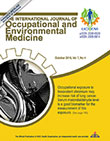فهرست مطالب

International Journal of Occupational and Environmental Medicine
Volume:7 Issue: 4, Oct 2016
- تاریخ انتشار: 1395/10/10
- تعداد عناوین: 11
-
-
Please Do Not Send Us Your Good Articles!Pages 197-198
-
Pages 199-206BackgroundGreat concern about occupational exposure to chromium (Cr [VI]) has been reported due to escalated risk of lung cancer in exposed workers. Consequences of occupational exposure to Cr (VI) have been reported as oxidative stress and lung tissue damage.ObjectiveTo investigate the feasibility of biological effect monitoring of chrome electroplaters through analysis of serum malondialdehyde (MDA).Methods90 workers directly involved in chrome electroplatingcategorized into three equal groups based on their job as near bath workers, degreaser, and washersand 30 workers without exposure to Cr (VI), served as the control group, were studied. Personal samples were collected and analyzed according to NIOSH method 7600. Serum MDA level was measured by HPLC using a UV detector.ResultsMedian Cr (VI) exposure level was 0.38 mg/m3 in near bath workers, 0.20 mg/m3 in degreasers, and 0.05 mg/m3 in washers. The median serum MDA level of three exposed groups (2.76 μmol/L) was significantly (pConclusionSerum MDA level is a good biomarker for the level of occupational exposure to Cr (VI) in electroplaters.Keywords: Chromium, Electroplating, Chromium hexavalent ion, Occupational exposure, Biological assay, Malondialdehyde
-
Pages 207-214BackgroundCall center sector in India is a relatively new and fast growing industry driving employment and growth in modern India today. Most international call centers in National Capital Region (NCR) of Delhi operate at odd work hours corresponding to a time suitable for their international customers. The sleep quality of call handlers employed in these call centers is in jeopardy owing to their altered sleep schedule.ObjectiveTo assess the sleep quality and determine its independent predictors among call handlers employed in international call centers in NCR of Delhi.MethodsA cross-sectional questionnaire-based study was conducted on 375 call handlers aged 1839 years employed in international call centers in NCR of Delhi. Sleep quality was assessed using Athens Insomnia scale along with a pre-tested, structured questionnaire.ResultsThe mean age of respondents was 24.6 (SD 2.4) years. 78% of participants were male. 83.5% of respondents were unmarried. 44.3% of call handlers were cigarette smokers. Physical ailments were reported by 37% call handlers. 77.6% of call handlers had some suspicion of insomnia or suspected insomnia; the rest had no sleep problem. Smoking, poor social support, heavy workload, lack of relaxation facility at office, and prolonged travel time to office were independent predictors of sleep quality (pConclusionCall handlers have to compromise upon their sleep owing to the contemporary work settings in call centers. Safeguarding their health becomes an occupational health challenge to public health specialists.Keywords: Telephone, Telecommunications, Sleep disorders, Social support
-
Pages 215-220BackgroundAdjustment disorder (AjD) is a transient mental health condition emerging after stressful life events. Its diagnostic criteria have recently been under revision which led to the development of the Adjustment DisorderNew Module 20 (ADNM-20) as a self-report assessment.ObjectiveTo identify a threshold value for people at high risk for AjD.MethodsAs part of a randomized controlled trial evaluating a self-help manual for burglary victims, the baseline data of all participants (n=80) were analyzed. Besides the ADNM-20, participants answered self-report questionnaires regarding the external variables post-traumatic stress disorder symptomatology, depression, anxiety, and stress levels. We used cluster analysis and ROC analysis to identify the most appropriate cut-off value.ResultsThe cluster analysis identified three different subgroups. They differed in their level of AjD symptomatology from low to high symptom severity. The same pattern of impairment was found for the external variables. The ROC analysis testing the ADNM-20 sum score against the theory-based diagnostic algorithm, revealed an optimal cut-off score at 47.5 to distinguish between people at high risk for AjD and people at low risk.ConclusionThe ADNM-20 distinguishes between people with low, moderate, and high symptomatology. The recommendation for a cut-off score at 47.5 facilitates the use of the ADNM-20 in research and practice.Keywords: Adjustment disorder, Trauma, stressor related disorders, Symptom assessment, Diagnosis
-
Pages 221-226BackgroundBrucellosis is the most common bacterial zoonosis worldwide. Greece has the highest reported incidence among EU countries. However, occupational risk factors have not been well described.ObjectiveTo determine the incidence patterns and exposure risk factors of brucellosis in Greece.MethodsWe used national-level surveillance and occupational denominator data to estimate the incidence patterns and exposure risk factors of brucellosis in Greece, with particular emphasis on occupation.ResultsBetween November 2003 and December 2015 a total of 2159 human brucellosis cases was reported. The mean incidence rate was 1.62 per 100 000 population per year. A large majority of cases (77.1%) reported consumption of unpasteurized milk or contact with livestock animals. Most cases occured in farmers and livestock breeders (1079 [87.7%] of 1231 cases reporting their occupation), corresponding to an annual incidence of 7.1 per 100 000. However, there were other occupations with a similar or higher risk: butchers and abattoir workers (12.7 per 100 000), laboratory personnel (3.1 per 100 000), while the highest risk was for veterinarians (53.2 per 100 000).ConclusionBrucellosis incidence in specific occupational groups was much higher than in the general population. These results underline the importance of collecting information on occupation, both during the diagnostic process and in the surveillance system. Besides efforts to control brucellosis in animals, organized prevention efforts are needed within an occupational health framework, especially for the most vulnerable workers.Keywords: Brucella, Brucellosis, Occupational exposure, Communicable diseases, Occupational diseases, Epidemiology
-
Pages 227-233BackgroundBenzene is one of the important occupational pollutants. There are some reports about the leukemogenic effects related to low-level exposure to benzene.ObjectiveTo study the frequency of micronucleus (MN), nucleoplasmic bridge (NB), and nuclear budding (NBUD) in the peripheral blood lymphocytes of petrochemical workers with low level exposure to benzene.MethodsWe enrolled 50 workers exposed to low-level benzene and 31 unexposed workers of a petrochemical industry. After exclusion of 3 samples, peripheral blood lymphocytes of the remaining 47 exposed and 31 unexposed workers were analyzed for the frequency of MN, NB, and NBUD by cytochalasin-blocked MN technique.ResultsMN was present in 28 (60%) exposed and 18 (58%) unexposed workers. NB was observed in 6 (13%), and 2 (7%) exposed and unexposed workers, respectively; the frequency for NBUD was 20 (43%), and 13 (42%), respectively. No significant difference was found in the observed frequencies of MN, NB, and NBUD in the peripheral blood lymphocytes between the exposed and unexposed group workers.ConclusionOccupational exposure to low-level benzene does not increase the frequency of MN, NB, and NBUD in the peripheral blood lymphocytes, biomarkers for DNA damage.Keywords: Benzene, Neoplasms, Leukemia, Cell nucleus, Cytoplasm, DNA damage
-
Pages 234-240BackgroundHealth care workers (HCW) are at high risk of contracting various infectious diseases and play a dual role in the transmission of infections in health care facilities.ObjectiveTo determine the seroprotection against hepatitis B, measles, rubella, and varicella among HCWs in a community hospital in Qatar.MethodsThis is a cross-sectional survey conducted in a 75-bed community hospital in Dukhan, Qatar. From August 2012 to December 2015, 705 HCWs were tested for the presence of IgG antibodies for measles, rubella, and varicella, and also for hepatitis B surface antigen (HBsAg). They were also asked about previous history of hepatitis B vaccination.Results595 (84.4%) HCWs received a full hepatitis B vaccination schedule; 110 (15.6%) received a single dose. The full schedule was reported with higher frequency by nurses (90.2%) compared to physicians (74.1%) or technicians (79.7%). Those aged ≥30 years (90.4%) andConclusionHCWs, particularly physicians, are not enough protected against hepatitis B. The seroprotection against measles, rubella, and varicella.Keywords: Hepatitis B, Measles, Rubella, Chickenpox, Seroepidemiologic studies, Vaccines, Cuba
-
Pages 241-242
-
Pages 243-244
-
Upcoming MeetingsPages 245-246
-
A Note of ThanksPage 1


